
If you’ve ever strolled through a garden in Florida or simply lounged in a backyard, you’ve likely had the pleasure of spotting one or two of the many lizards that call the Sunshine State home. But did you know that Florida is a hotspot for both native and invasive lizards? From the vibrant Green Anole, a true local, to the feisty Brown Anole, an uninvited guest from the Bahamas and Cuba, the range of lizards in Florida tells a fascinating tale of survival, adaptation, and the delicate balance of nature. As these little critters sun themselves or dart about, they’re also playing a role in a much larger ecological story, full of both harmony and competition. So, let’s meet some of Florida’s 40 most popular reptilian residents!
Table of Contents
1. Green Anole (Anolis carolinensis)
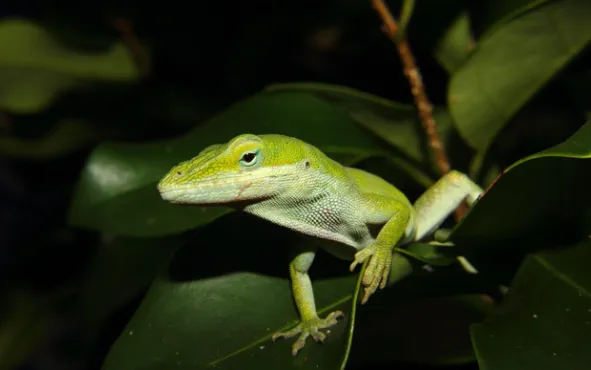
Scientific Information
- Scientific Name: Anolis carolinensis
- Common Names: Green Anole, Carolina Anole
Origins and Habitats
The Green Anole is native to the southeastern United States and can be found from Texas to Florida and north to North Carolina. Known as the “American chameleon” due to its ability to change color, it’s a staple in the warm, humid environments of the American South.
Physical Characteristics
- Size: The Green Anole typically measures between 5 to 8 inches in length. Their light build makes them agile climbers and jumpers.
- Body Features: The Green Anole has a slender body, a long tail, and adhesive pads on its toes, aiding in its arboreal lifestyle. Males boast a red or pink dewlap, which they use to attract females and deter rival males.
- Coloration and Patterns: Predominantly bright green, the Green Anole can change its color to brown or gray, depending on its mood, health, or environment. This ability is often incorrectly associated with chameleons.
Diet
Green Anoles are insectivores, feasting on a variety of insects such as crickets, beetles, and flies. They’ll also partake in spiders and other small invertebrates. Their sticky, extendable tongue makes catching quick prey a breeze.
Environmental Impact
The Green Anole is a crucial part of its ecosystem, acting as both predator and prey. They help control insect populations and, in turn, provide
Unfortunately, their position in their native habitats is under threat, especially in places like Florida, where the invasive Brown Anole competes for the same resources. The competition has driven the Green Anole to adapt by living higher in trees and shrubs.
2. Brown Anole (Anolis sagrei)
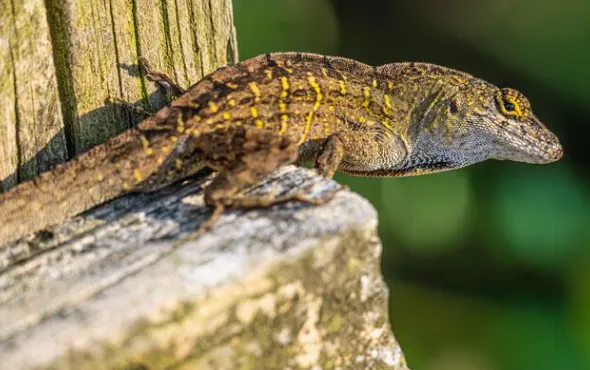
Scientific Information
- Scientific Name: Anolis sagrei
- Common Names: Brown Anole
Origins and Habitats
The Brown Anole is originally native to the Bahamas and Cuba. However, it has established itself firmly in Florida and other parts of the southeastern United States. This adaptability has made it a common sight in urban gardens, parks, and forests.
Physical Characteristics
- Size: A relatively small lizard, the Brown Anole usually measures between 3 to 7 inches in length.
- Body Features: The Brown Anole has a slender body and a pointed snout. Males are generally larger than females and possess a dewlap (a flap of skin) under their necks, which they display for territorial or mating purposes.
- Coloration and Patterns: While generally brown, they can change their color to a degree, shifting between brown and dark brown to match their surroundings. They also feature a lighter stripe down their back.
Diet
These opportunistic feeders primarily consume insects like crickets, beetles, and moths. They also eat spiders and, occasionally, smaller lizards or lizard eggs. Their diet changes with availability, making them flexible survivors in varied habitats.
Environmental Impact
The introduction of the Brown Anole in regions outside its native habitat, especially in Florida, has had a noticeable impact on native species, particularly the Green Anole. The Brown Anole’s aggressive nature and adaptability mean it often outcompetes the Green Anole for resources, pushing the latter to higher, less familiar grounds.
Though they might be seen as a nuisance or threat to native species, the Brown Anole also plays a role in local ecosystems by helping control insect populations. Their presence is a testament to the delicate balance of nature and how even small shifts can lead to significant ecological changes.
3. Knight Anole (Anolis equestris)
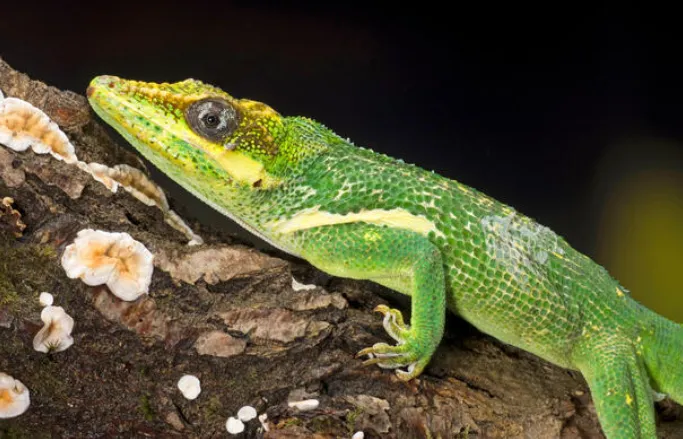
Scientific Information
- Scientific Name: Anolis equestris
- Common Names: Knight Anole
Origins and Habitats
Originating from Cuba, the Knight Anole has made its mark in Florida, becoming an introduced species in the region. These lizards thrive in tropical and subtropical forests, often preferring habitats with a lot of foliage and trees.
Physical Characteristics
- Size: One of the largest species within the Anolis genus, the Knight Anole can grow up to 13 to 20 inches in length, including its tail.
- Body Features: This species boasts a robust and slightly compressed body, complemented by a long, tapering tail. They have strong limbs, which aid in their adept tree-climbing abilities.
- Coloration and Patterns: Knight Anoles are primarily bright green, which helps camouflage them among leaves. However, when threatened or displaying dominance, they can show mottled patterns in shades of brown.
Diet
Knight Anoles are insectivores and will generally eat a variety of invertebrates like insects, spiders, and even other smaller lizards. As they grow larger, their diet can extend to include more substantial prey, like tree snails.
Environmental Impact
As an invasive species in Florida, the Knight Anole can pose threats to native species by outcompeting them for
Knight Anoles, while impressive in their size and appearance, are a reminder of the intricate balance of ecosystems and how easily they can be disrupted. They play a role in controlling insect populations, but their presence outside their native habitat can lead to unforeseen consequences for native flora and fauna.
4. Bark Anole (Anolis distichus)
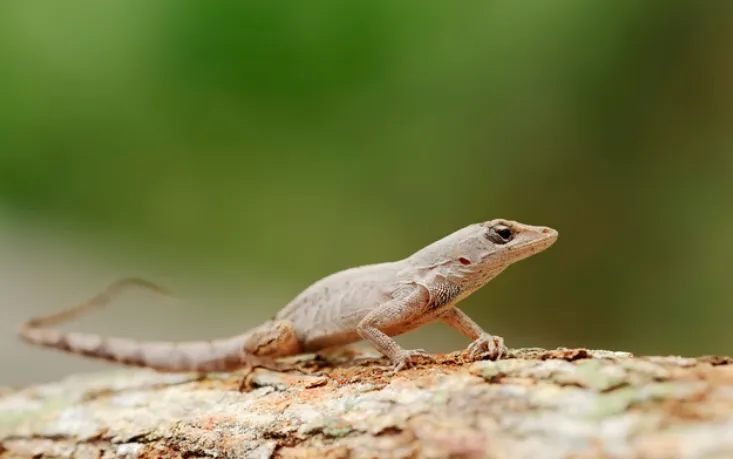
Scientific Information
- Scientific Name: Anolis distichus
- Common Names: Bark Anole
Origins and Habitats
Originally from the Bahamas, the Bark Anole has found a suitable home in southeastern parts of Florida, particularly enjoying human-made environments such as gardens and parks.
Physical Characteristics
- Size: Generally 4 to 7 inches long, lightweight.
- Body Features: Like other anoles, it has a slender build with a slightly pointed snout.
- Coloration and Patterns: Typically a gray-brown or olive background color, often with light stripe patterns down their back, which allows them to blend seamlessly with tree barks and branches.
Diet
Predominantly insectivores, they feed on a range of insects including beetles, ants, and spiders.
Environmental Impact
Being an introduced species, there’s a possibility of competition with native species for resources. However, due to their preference for disturbed habitats, they are less likely to impact pristine environments. However their exact impact on native ecosystems in Florida remains a topic of study.
5. Cuban Green Anole (Anolis porcatus)
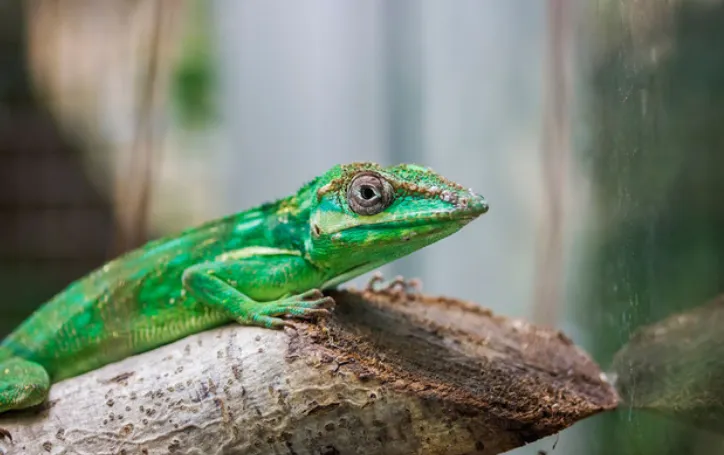
Scientific Information
- Scientific Name: Anolis porcatus
- Common Names: Cuban Green Anole, Cuban Anole
Origins and Habitats
As its name suggests, the Cuban Green Anole is native to Cuba. However, it has established itself in certain parts of Florida, likely introduced through the pet trade or accidental transport.
Physical Characteristics
- Size: Generally ranging from 5 to 8 inches in length, with males typically being larger than females.
- Body Features: Sleek and agile, these anoles have elongated bodies and a dorsal crest that is more pronounced in males.
- Coloration and Patterns: Bright green is the predominant color, although they can change to brown depending on their mood, health, or environmental factors. This color-changing ability helps them communicate and camouflage.
Diet
Primarily insectivorous, the Cuban Green Anole enjoys a diet of crickets, beetles, moths, and other small invertebrates. They might also occasionally feast on smaller lizards or their eggs.
Environmental Impact
Their presence in Florida has led to competition with native anole species, especially the Carolina anole. They are known to be more aggressive than some native species, which could lead to displacement or even a decrease in native anole populations in areas where the Cuban Green Anole is prevalent.
6. Large-headed Anole (Anolis cybotes)
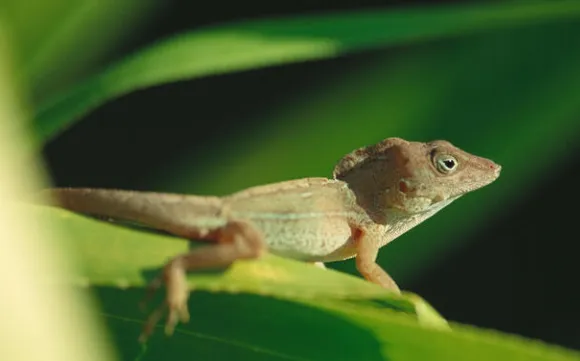
Scientific Information
- Scientific Name: Anolis cybotes
- Common Names: Large-headed Anole, Haitian Giant Anole
Origins and Habitats
Originally from the island of Hispaniola, which comprises Haiti and the Dominican Republic, the Large-headed Anole has been spotted in select areas of Florida, likely due to pet releases or unintentional introductions.
Physical Characteristics
- Size: The Large-headed Anole ranges from 7 to 9 inches in length, with its size being one of its distinctive features.
- Body Features: As the name implies, this species boasts a notably large head, especially in mature males. This gives them a robust and formidable appearance, especially when compared to other anoles.
- Coloration and Patterns: Their base color is generally a brownish or olive green, adorned with patterns of darker spots or bands. The males often exhibit a pale dewlap (throat fan) that can be extended for communication and territorial displays.
Diet
The diet of the Large-headed Anole is diverse and consists of insects such as crickets, beetles, and spiders. However, due to their size, they might occasionally feed on smaller anoles and other small animals.
Environmental Impact
Their introduction to Florida might pose competition threats to native species, especially for resources and territory. Being larger and aggressive, they can have an advantage over the native species, which might disrupt the local ecological balance.
7. Florida Scrub Lizard (Sceloporus woodi)
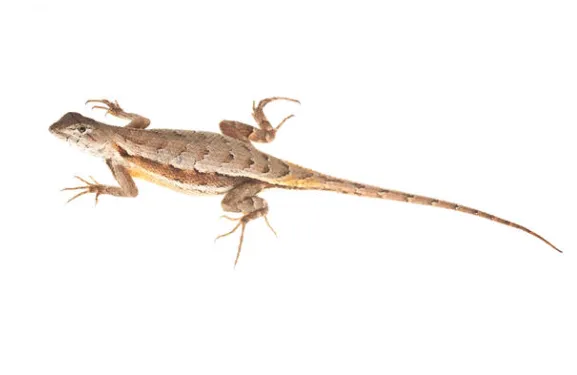
Scientific Information
- Scientific Name: Sceloporus woodi
- Common Names: Florida Scrub Lizard
Origins and Habitats
The Florida Scrub Lizard is a native species, unique to the central and northern parts of the Florida peninsula. It has specifically evolved to inhabit the sandy, well-drained uplands known as scrub habitats. These scrubs, characterized by their xeric (dry) conditions, consist of scattered trees, shrubs, and open areas of sand.
Physical Characteristics
- Size: Generally, the Florida Scrub Lizard is a small lizard that ranges from 5 to 7.5 inches in length, from the tip of the nose to the end of the tail.
- Body Features: These lizards have a slender body with granular scales and a tail that’s longer than the body. They have a distinguishing dorsal stripe down their back, and their toes are fringed, which aids them in running on sandy terrains.
- Coloration and Patterns: Typically, they are gray or light brown in color, blending seamlessly with their sandy habitats. Males can be distinguished by blue patches on the sides of their belly and throat.
Diet
Florida Scrub Lizards primarily feed on small insects, including ants, beetles, and spiders. Their diet can vary based on the availability of prey in their specific habitat.
Environmental Impact
Being a native species, the Florida Scrub Lizard plays a role in its ecosystem by controlling insect populations and serving as prey for larger predators. However, due to habitat destruction, particularly the loss of scrub habitats for development, their populations are under threat. Conservation efforts are ongoing to protect and restore these unique habitats to ensure the survival of species like the Florida Scrub Lizard.
8. Southeastern Five-lined Skink (Plestiodon inexpectatus)
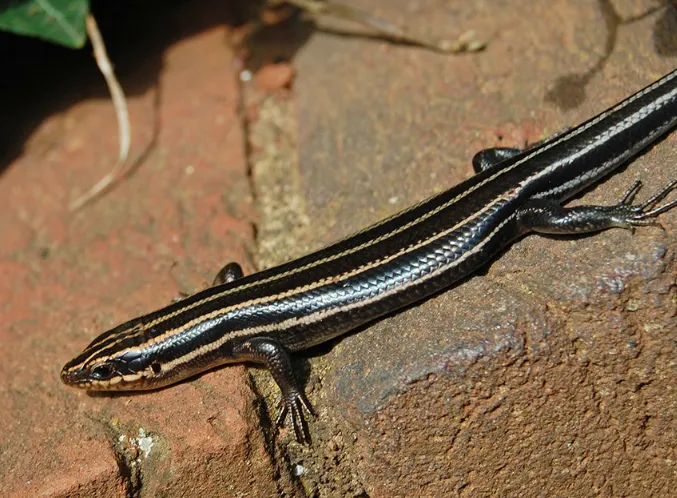
Scientific Information
- Scientific Name: Plestiodon inexpectatus
- Common Names: Southeastern Five-lined Skink
Origins and Habitats
The Southeastern Five-lined Skink is native to the southeastern United States and is predominantly found throughout Florida. They prefer habitats like hardwood forests, pine flatwoods, and mixed woodlands, often residing in areas with an abundance of ground cover and leaf litter.
Physical Characteristics
- Size: This species typically ranges from 5 to 8.5 inches in total length, including the tail.
- Body Features: The Southeastern Five-lined Skink possesses a sleek, elongated body with short legs. Their most notable feature is the five light stripes that run down the length of their body, contrasting against a darker background. Juveniles have a bright blue tail, which fades as they age.
- Coloration and Patterns: The background color can be gray, brown, or black, with five distinctive light stripes. The middle stripe usually extends to the tip of the tail, and the stripes can become less distinct as the skink matures.
Diet
These skinks are insectivores and primarily feed on a variety of insects such as beetles, crickets, and caterpillars. Occasionally, they might consume small spiders and other arthropods.
Environmental Impact
The Southeastern Five-lined Skink plays an integral role in controlling insect populations in its habitat, which can help in maintaining a balanced ecosystem. These skinks also serve as a
9. Ground Skink (Scincella lateralis)
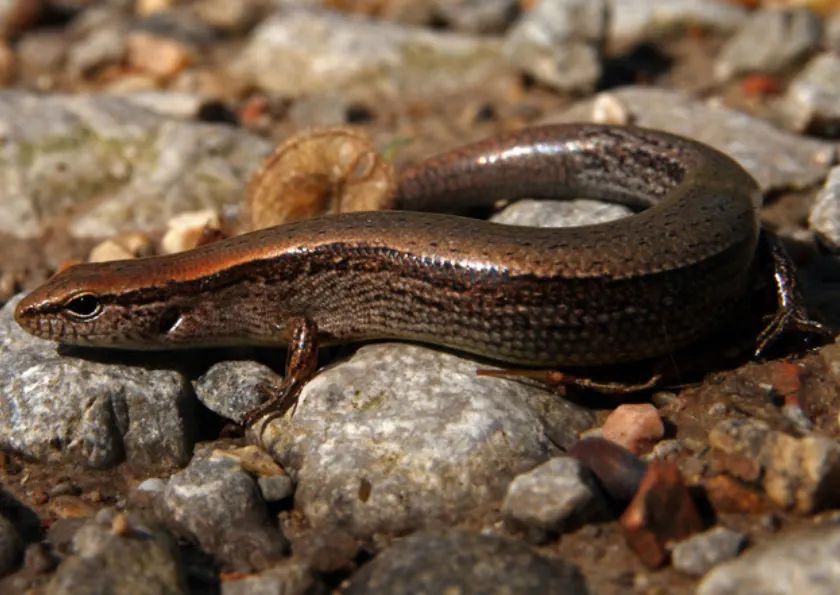
Scientific Information
- Scientific Name: Scincella lateralis
- Common Names: Ground Skink, Little Brown Skink
Origins and Habitats
The Ground Skink is native to the southeastern United States, making its presence known across various parts of Florida. It has a preference for ground habitats and is typically found lurking in the leaf litter of forests, fields, and even in backyards. Its habitats range from deciduous forests to pine woodlands and grasslands, and they’re especially fond of areas with plenty of leaf litter and loose soil where they can burrow and hide.
Physical Characteristics
- Size: One of the tiniest lizards you might come across, the Ground Skink typically measures between 3 to 5.5 inches from snout to tail tip.
- Body Features: This skink is characterized by its slender, elongated body with smooth and shiny scales that overlap. While they have small legs, they are quite quick, especially when darting through leaves or undergrowth.
- Coloration and Patterns: A rich bronze or brown uniformly graces their body, with some having a hint of a stripe running down their back. However, these stripes are often faint. The belly is usually a clearer, light shade, often whitish or pale.
Diet
Ground Skinks primarily feed on tiny invertebrates, like spiders, ants, beetles, and other insects. Their diet is adjusted based on their habitat and what’s available, but they are particularly skilled at hunting in the leaf litter and catching their prey with precision.
Environmental Impact
In their native habitat, Ground Skinks play a role in controlling insect populations. They also act as prey for larger predators, including birds, larger lizards, and some mammals. In the ecosystem, they help in nutrient cycling and also in aerating the soil when they burrow. Their presence often indicates a healthy undergrowth ecosystem due to their reliance on leaf litter and a diverse diet of small invertebrates.
10. Mole Skink (Plestiodon egregius)
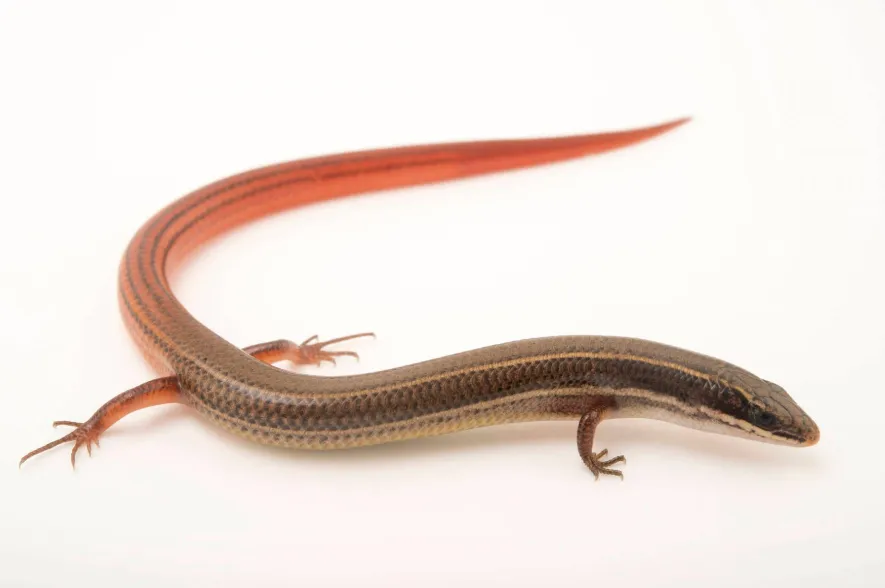
Scientific Information
- Scientific Name: Plestiodon egregius
- Common Names: Mole Skink
Origins and Habitats
The Mole Skink is native to the southeastern United States, predominantly found in Florida and parts of Georgia. True to its name, the Mole Skink is a burrowing species, commonly inhabiting well-drained sandy areas like scrublands, sandhills, and coastal dunes.
Physical Characteristics
- Size: Mole Skinks are relatively small lizards, with adults typically measuring between 3 to 5 inches in length.
- Body Features: They possess a slender, elongated body and a short, stubby tail. Their legs are reduced in size, making them appear more snake-like, which facilitates their burrowing lifestyle.
- Coloration and Patterns: Coloration can vary depending on the subspecies and region. Some have a shiny, iridescent quality to their scales, with colors ranging from bronze to pinkish or bluish. The belly is typically whitish or pale.
Diet
Primarily insectivores, Mole Skinks feed on a variety of small invertebrates like insects, spiders, and worms. Their burrowing behavior allows them to access subterranean prey with ease.
Environmental Impact
Due to their specific habitat requirements, Mole Skinks are vulnerable to habitat loss, particularly from urban development and changes in land use. Their preference for sandy environments means they can be particularly affected by activities like sand mining or extensive agriculture.
Mole Skinks are often unnoticed due to their secretive, burrowing nature. However, they play a crucial role in their ecosystems, aiding in the control of insect populations and serving as prey for larger predators. In areas where they are prevalent, they are an indicator of a healthy, well-balanced ecosystem. Potential threats to their population and habitat make it essential to consider conservation measures and habitat preservation to ensure their continued survival.
11. Broad-headed Skink (Plestiodon laticeps)
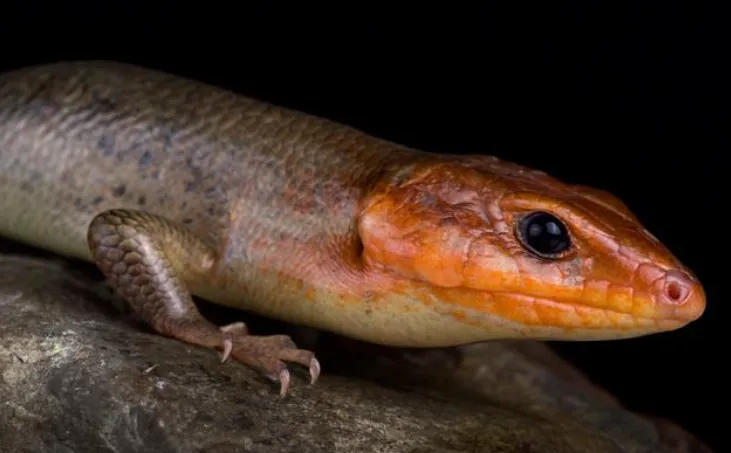
Scientific Information
- Scientific Name: Plestiodon laticeps
- Common Names: Broad-headed Skink, Red-headed Skink
Origins and Habitats
The Broad-headed Skink is predominantly found in the southeastern United States, and its range covers parts of Florida. It has an affinity for wooded habitats, especially areas with plenty of trees and fallen logs. They are usually seen climbing trees, where they search for prey and bask in the sun. They also prefer areas with abundant leaf litter and logs on the forest floor.
Physical Characteristics
- Size: Among the largest skinks in its range, the Broad-headed Skink can grow between 6.5 to 13 inches in length.
- Body Features: It has a robust and elongated body, with males showcasing broader heads compared to females. Males also have enlarged jaws, making their heads look even more prominent.
- Coloration and Patterns: The males, especially during breeding season, flaunt a bright orange or red head, which stands out against their olive-brown to black body. Young Broad-headed Skinks and adult females have five light stripes running along their body, but these stripes often fade as the skinks mature.
Diet
These skinks are carnivorous and primarily feed on various insects, spiders, and other small invertebrates. Occasionally, they may also consume smaller lizards. Their tree-climbing abilities allow them to access a variety of prey, including those on tree trunks and leaves.
Environmental Impact
Broad-headed Skinks play a vital role in the ecosystems they inhabit. By preying on various invertebrates, they help control insect populations, which can indirectly benefit plants and other smaller creatures. At the same time, these skinks are a
12. Six-lined Racerunner (Aspidoscelis sexlineatus)
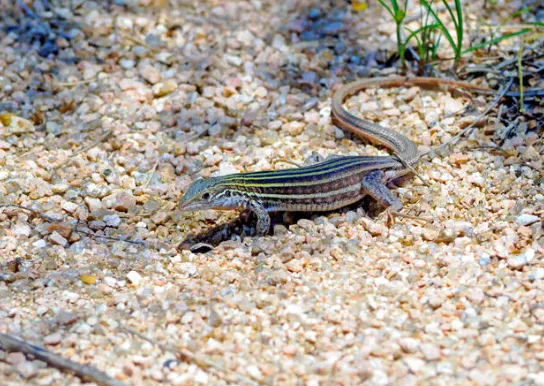
Scientific Information
- Scientific Name: Aspidoscelis sexlineatus
- Common Names: Six-lined Racerunner
Origins and Habitats
The Six-lined Racerunner is native to the southeastern United States, including parts of Florida. Preferring open areas, this lizard can often be found in sandy environments, grasslands, and light woodlands. It has a fondness for sunny spots, often seen basking or racing through open patches of ground.
Physical Characteristics
- Size: Typically, the Six-lined Racerunner measures between 6.5 to 9.5 inches in total length.
- Body Features: As the name suggests, it possesses a slender, streamlined body that’s adapted for quick movements. Its long tail, often more than twice the length of its body, aids in balance during its rapid sprints.
- Coloration and Patterns: Distinctive for its six bright yellow or green-yellow stripes running down its back from head to tail, the Six-lined Racerunner’s background color is usually dark green or black, allowing the stripes to stand out prominently. Its underside is typically white or pale blue, especially in males.
Diet
Being insectivorous, the Six-lined Racerunner feeds primarily on insects such as crickets, beetles, and grasshoppers. It also eats spiders and other small invertebrates. Its speed is a significant advantage, allowing it to chase down and catch swift prey.
Environmental Impact
The Six-lined Racerunner, being a voracious insect eater, helps maintain a balance in insect populations in its habitat. By keeping certain insect numbers in check, it indirectly aids in preserving the health of its ecosystem. Simultaneously, the racerunner provides a
13. Mediterranean Gecko (Hemidactylus turcicus)
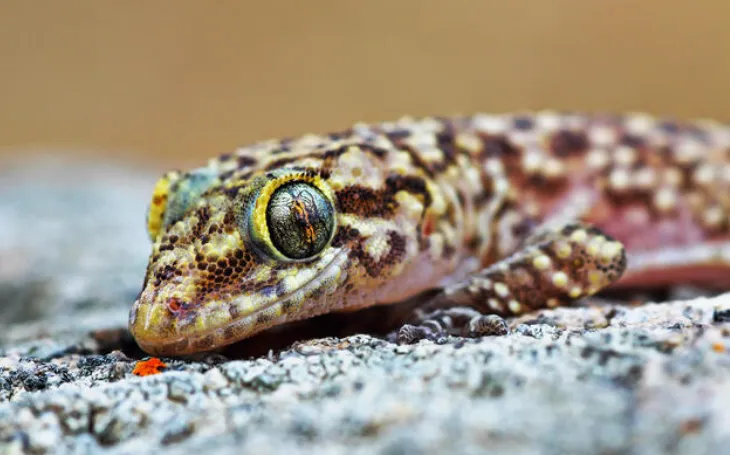
Scientific Information
- Scientific Name: Hemidactylus turcicus
- Common Names: Mediterranean Gecko, Turkish Gecko
Origins and Habitats
The Mediterranean Gecko originates from the Mediterranean region, true to its name. However, its adaptable nature has allowed it to establish populations in various global locations, including the southern United States, particularly in Florida, Texas, and Louisiana. Within these regions, they show a preference for urban settings. The structures and buildings in cities offer them shelter, while the consistent presence of insects provides a reliable
Physical Characteristics
- Size: Adult Mediterranean Geckos typically measure between 4 to 5 inches in length.
- Body Features: These geckos possess soft, velvety skin and have toe pads equipped with tiny scales, which allow them to effortlessly cling to and climb various surfaces, including smooth walls.
- Coloration and Patterns: Their color can vary from pale pinkish-tan to light brown. They often exhibit dark spots, and when disturbed or stressed, the patterns become more pronounced.
Diet
The diet of the Mediterranean Gecko primarily consists of insects and arthropods. With their nocturnal lifestyle, they hunt at night, feeding on moths, spiders, ants, and other small creatures. Their presence can be beneficial in reducing unwanted insect populations.
Environmental Impact
In their introduced habitats, like parts of the southern United States, they are beneficial in controlling insect populations, especially around human dwellings. However, being an invasive species, there is always a potential for them to outcompete and threaten native species. Their adaptability and rapid reproduction rate can make them dominant in certain environments.
Conservationists monitor the spread of such species to ensure they don’t drastically alter the native ecosystems. Still, in most of their introduced regions, they’ve integrated without causing significant disruptions. In many places, people appreciate them as natural pest controllers, especially in urban settings.
14. Indo-Pacific Gecko (Hemidactylus garnotii)
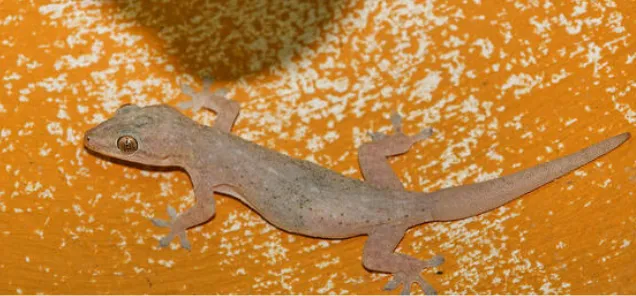
Scientific Information
- Scientific Name: Hemidactylus garnotii
- Common Names: Indo-Pacific Gecko, Garnot’s House Gecko, Fox Gecko
Origins and Habitats
The Indo-Pacific Gecko is native to Southeast Asia and the western Pacific islands but has found its way to various parts of the world due to human-mediated transportation, including Florida. This gecko prefers habitats with mild climates and is often seen dwelling in urban and suburban settings. They can be found on walls, trees, and buildings where lights attract their insect prey.
Physical Characteristics
- Size: These geckos are relatively small, typically ranging from 4 to 5 inches in length.
- Body Features: They possess a sleek, somewhat flattened body. Their skin is slightly translucent, which gives them a soft appearance. They have adhesive toe pads which enable them to easily climb surfaces.
- Coloration and Patterns: Indo-Pacific Geckos are unique in their coloration. Males are generally brownish or gray, while females and juveniles are pale with a beige or pinkish hue. At night, their color tends to become darker. This gecko lacks noticeable patterns, maintaining a solid color throughout its body.
Diet
The Indo-Pacific Gecko’s diet primarily consists of insects and other small invertebrates. Their affinity for areas with artificial lighting is largely due to the abundance of insects these places attract.
Environmental Impact
As an introduced species in places like Florida, the Indo-Pacific Gecko has become a naturalized resident. Their impact on the local environment isn’t fully understood, but like other geckos, they might compete with native species for
15. Tropical House Gecko (Hemidactylus mabouia)
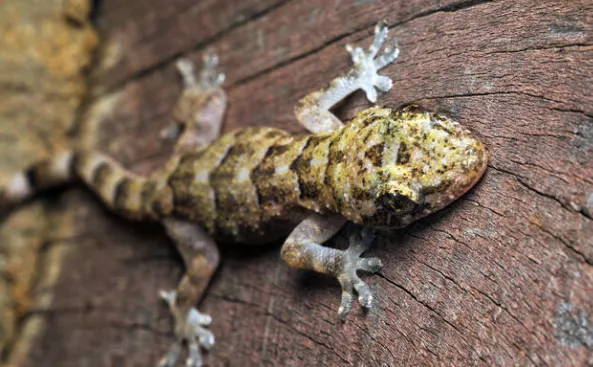
Scientific Information
- Scientific Name: Hemidactylus mabouia
- Common Names: Tropical House Gecko, Wood Slave
Origins and Habitats
The Tropical House Gecko is indigenous to sub-Saharan Africa but has expanded its range due to human activity, making its way to various parts of the tropical world, including the Caribbean and Florida. They are commonly seen in urban environments and are particularly attracted to residential structures, hence their name. These geckos have adapted well to human habitation, and they frequently inhabit walls, ceilings, and other structures, especially those illuminated at night which attract insects.
Physical Characteristics
- Size: Typically, these geckos range from 2.5 to 4 inches in length.
- Body Features: The Tropical House Gecko has a somewhat robust build with large, prominent eyes that lack eyelids, a characteristic feature of geckos. Their toes are equipped with adhesive pads, which allows them to climb effortlessly on vertical surfaces, including smooth walls and ceilings.
- Coloration and Patterns: Their color can range from pale tan to dark brown, often with mottled patterns that serve as camouflage against tree bark or other surfaces. The body’s underside is usually lighter, often white or pale cream.
Diet
Mainly insectivorous, the Tropical House Gecko feeds on a variety of insects, particularly those that are attracted to artificial lights. They play a beneficial role in homes by controlling the populations of insects like mosquitoes and moths.
Environmental Impact
The Tropical House Gecko’s introduction outside its native range, especially in places like Florida, has placed it in direct competition with native gecko species for resources. While they help control insect populations in residential areas, the extent of their impact on local ecosystems is not entirely clear. Their presence underscores the intricate balance of ecosystems and the potential implications of introducing non-native species, whether intentionally or accidentally.
16. Common House Gecko (Hemidactylus frenatus)
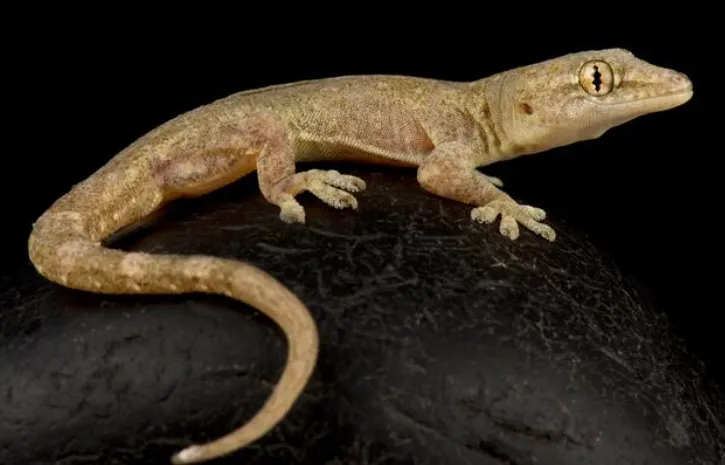
Scientific Information
- Scientific Name: Hemidactylus frenatus
- Common Names: Common House Gecko, Pacific House Gecko, Asian House Gecko, Wall Gecko, Moon Lizard
Origins and Habitats
The Common House Gecko originates from Southeast Asia, but due to its adaptability, it has spread to many other parts of the world, including Australia, the Pacific Islands, and the southern United States, particularly in Florida. As its name suggests, this gecko is often found in and around human dwellings. They thrive in tropical and subtropical environments, typically in urban and suburban areas where they can be found on walls, ceilings, and other structures.
Physical Characteristics
- Size: Common House Geckos are generally small, with adult lengths ranging from 3 to 5 inches.
- Body Features: These geckos possess a flattened body with large, lidless eyes that have vertical pupils. Their feet are adapted for climbing with adhesive toe pads, enabling them to navigate a variety of surfaces.
- Coloration and Patterns: Their color can vary based on their environment, ranging from light gray to brown. They often have patterns on their skin which can be a series of dots, dashes, or irregular shapes that help them blend into their surroundings.
Diet
The diet of the Common House Gecko primarily consists of insects and other small invertebrates. They are particularly fond of moths, flies, and mosquitoes, making them beneficial residents around homes as they help reduce pesky insect populations.
Environmental Impact
The adaptability of the Common House Gecko means it can quickly establish itself in new environments, potentially outcompeting native species for resources. In areas where it’s introduced, there’s concern about its impact on native gecko populations and the broader ecosystem. On the plus side, as voracious insect eaters, they can help control pest populations in and around human habitations. However, a comprehensive understanding of their environmental impact requires more in-depth studies, especially in regions where they’re not native.
17. Ashy Gecko (Sphaerodactylus elegans)
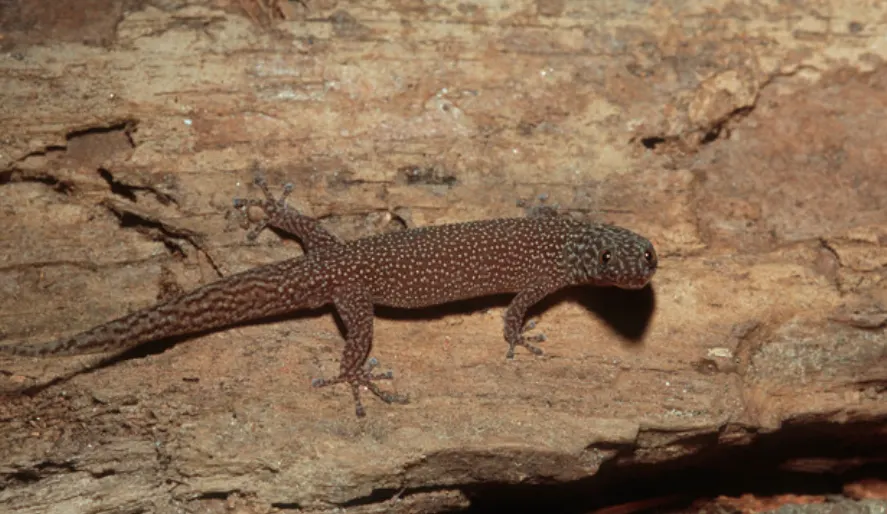
Scientific Information
- Scientific Name: Sphaerodactylus elegans
- Common Names: Ashy Gecko, Elegant Gecko
Origins and Habitats
The Ashy Gecko is native to the Caribbean, specifically the Bahamas, Cuba, and the Cayman Islands. Over time, this species has been introduced to areas of Florida, where they’ve established populations. They thrive in tropical environments and can often be found in leaf litter, rock crevices, tree barks, and sometimes even within human dwellings.
Physical Characteristics
- Size: The Ashy Gecko is one of the smaller gecko species, with adults typically measuring between 1.5 to 2 inches in length.
- Body Features: They have a delicate build, with slender bodies and long, thin tails. Their eyes are large in proportion to their heads and have vertical pupils.
- Coloration and Patterns: Their dorsal coloration ranges from gray to brown, with a grainy appearance that gives them the “ashy” descriptor. They may also have light-colored bands or stripes along their bodies. The underside is usually lighter, often a creamy or pale gray.
Diet
Ashy Geckos are insectivores, primarily feeding on small insects, including ants, spiders, and tiny beetles. Their diet might also occasionally include small fruit particles or nectar.
Environmental Impact
As an introduced species in Florida, there’s some concern regarding their potential impact on local ecosystems. While their presence can be beneficial in controlling certain insect populations, they could also compete with native species for
18. Yellow-headed Gecko (Gonatodes albogularis)
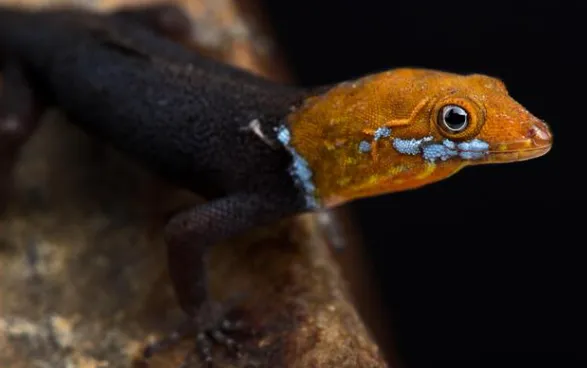
Scientific Information
- Scientific Name: Gonatodes albogularis
- Common Names: Yellow-headed Gecko, White-throated Gecko
Origins and Habitats
The Yellow-headed Gecko is originally from Central America, with its range extending from southern Mexico through Central America and into northern South America. In recent years, this species has been introduced and has established populations in parts of Florida, possibly through the pet trade. They are typically found in tropical and subtropical habitats, preferring areas with plenty of vegetation and suitable hiding places like rock crevices or underneath tree barks.
Physical Characteristics
- Size: This gecko is on the smaller side, usually reaching lengths of about 2 to 3 inches from snout to vent.
- Body Features: The Yellow-headed Gecko has a slender body and a somewhat flattened head, with delicate limbs and a long, tapering tail.
- Coloration and Patterns: As the common name suggests, the most notable feature is its vibrant yellow or cream-colored head, which contrasts sharply with its darker body. The body can range from gray to brown, often adorned with dark markings or bands.
Diet
Yellow-headed Geckos have an insectivorous diet. They prey on a range of small insects like ants, beetles, and spiders. Their keen eyesight and agility make them adept hunters, allowing them to stalk and pounce on their prey effectively.
Environmental Impact
As an introduced species in areas like Florida, the Yellow-headed Gecko’s impact on local ecosystems is still being studied. While they might compete with native species for
19. Tokay Gecko (Gekko gecko)
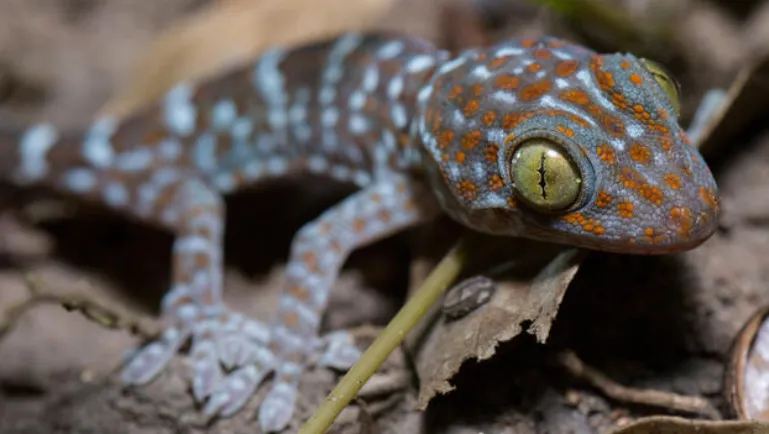
Scientific Information
- Scientific Name: Gekko gecko
- Common Names: Tokay Gecko
Origins and Habitats
Originating from Southeast Asia, the Tokay Gecko can be found sprawling across countries like India, Philippines, and parts of Indonesia. Their preferred habitats include rainforests, urban areas, and even agricultural fields. Due to the pet trade, the Tokay Gecko has been introduced to places like Florida, where they are considered an invasive species.
Physical Characteristics
- Size: Among the heftier geckos, Tokay Geckos can reach lengths of up to 15 inches, with males typically being larger than females.
- Body Features: They possess a robust and somewhat stocky build. Their toes are equipped with adhesive lamellae, allowing them to effortlessly climb surfaces.
- Coloration and Patterns: Sporting a striking color palette, Tokay Geckos are adorned with bright blue or grayish bodies sprinkled with vibrant orange-red spots and blotches. This combination not only aids in camouflage amidst tropical foliage but also makes them a favorite in the pet trade.
Diet
Tokay Geckos are opportunistic predators. Their diet primarily consists of insects like moths and beetles, but they aren’t averse to consuming smaller lizards and even small vertebrates when the opportunity arises.
Environmental Impact
In places where they’ve been introduced, such as Florida, Tokay Geckos could potentially compete with native species for resources. They might also prey upon smaller native species. The full environmental implications of their introduction are still being studied, but it’s always vital to approach invasive species with caution and ensure we don’t disturb local ecological balances.
20. African Red-headed Agama (Agama agama)
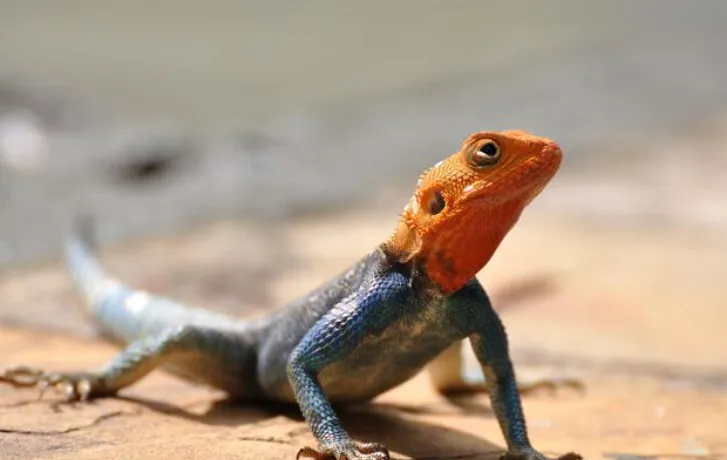
Scientific Information
- Scientific Name: Agama agama
- Common Names: African Red-headed Agama, Rainbow Agama, Common Agama
Origins and Habitats
Originating from the sub-Saharan regions of Africa, the African Red-headed Agama thrives in various habitats ranging from savannahs to open forests. They are known to be quite adaptable and can be found in different environments as long as there’s sufficient sunlight and heat.
Physical Characteristics
- Size: These medium-sized lizards can grow up to 12-14 inches in length. Males are generally larger than females.
- Body Features: The Agama has a somewhat elongated body with a long, tapering tail used for balance.
- Coloration and Patterns: The male’s striking bright red or orange head, neck, and shoulders make this species especially distinctive. Their bodies are usually a glossy bluish-black. Females and juveniles, in contrast, are less colorful, often brown or olive green with some light patterning.
Diet
Primarily insectivorous, the African Red-headed Agama’s diet consists of ants, beetles, crickets, and other small invertebrates. They occasionally consume plant matter, such as berries, when insects are scarce.
Environmental Impact
African Red-headed Agamas have been introduced in some parts of the world, including Florida, due to the pet trade. Their presence in non-native regions poses a risk to local ecosystems as they might compete with native species for
21. Nile Monitor (Varanus niloticus)
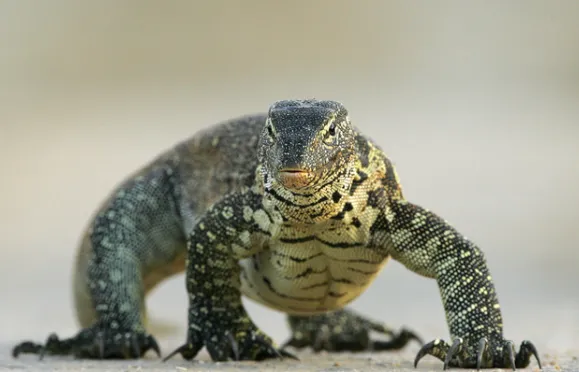
Scientific Information
- Scientific Name: Varanus niloticus
- Common Names: Nile Monitor, African Small-grain Lizard, Water Leguaan
Origins and Habitats
The Nile Monitor hails from Africa, predominantly dwelling along the Nile River’s length. Their habitat range extends through a wide swathe of the continent, covering sub-Saharan Africa and even reaching parts of the North African coast. They are largely found in freshwater habitats such as rivers, lakes, and marshes, but they’re also known to venture into coastal regions and brackish waters.
Physical Characteristics
- Size: One of the largest lizards in Africa, Nile Monitors can grow to lengths of up to 7 feet, although most average around 4-5 feet.
- Body Features: Sporting a strong and muscular build, they have powerful limbs, sharp claws, and an elongated tail, which aids in swimming.
- Coloration and Patterns: They have a tough, scaly skin adorned with an intricate pattern of light and dark markings. Their dorsal side is generally dark, decorated with light yellowish to olive-colored spots, which transition to bands on the tail.
Diet
Nile Monitors are carnivorous and will eat almost anything they can overpower. Their diet includes fish, amphibians, birds, small mammals, insects, and even carrion. Younger monitors will lean more towards a diet of insects, while the older, larger monitors might even hunt down small crocodiles.
Environmental Impact
The Nile Monitor’s adaptability has resulted in its introduction to non-native regions, particularly in places like Florida, where it is seen as an invasive species. These lizards can pose threats to native wildlife due to their predatory nature. They are known to prey upon the eggs of American crocodiles and various native turtles, potentially disrupting the local ecological balance. The pet trade, coupled with releases or escapes, has facilitated their spread in regions outside their native habitats.
22. Black and White Tegu (Salvator merianae)
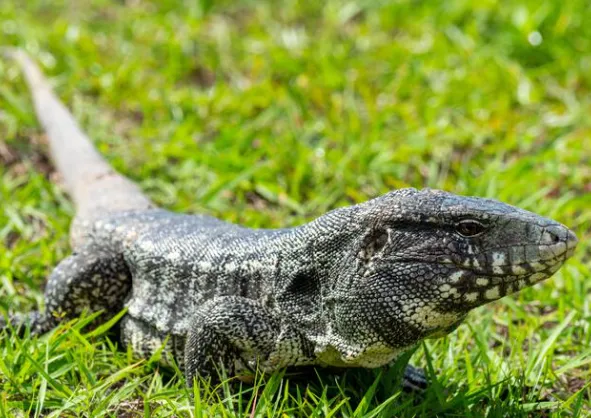
Scientific Information
- Scientific Name: Salvator merianae
- Common Names: Black and White Tegu, Argentine Tegu, Giant Tegu
Origins and Habitats
The Black and White Tegu is native to South America, primarily found in Argentina, Brazil, Paraguay, and Uruguay. They inhabit a variety of environments, from rainforests and savannas to swampy areas and dry woodlands. Their adaptability has allowed them to thrive in different habitats within their native range.
Physical Characteristics
- Size: Black and White Tegus are among the largest lizards in South America, growing up to 4.5 feet in length. Adult Tegus generally weigh between 10 to 15 pounds, although some might get even heavier.
- Body Features: They possess a stocky, muscular build with strong limbs and a robust tail. Their bodies are slightly elongated, allowing for efficient movement both on land and in water.
- Coloration and Patterns: True to their common name, their scales showcase a contrast of black and white banding. Their dorsal side predominantly displays this pattern, which often breaks into spots on the legs and tail.
Diet
These Tegus are omnivorous, with a varied diet that includes fruits, vegetables, insects, small rodents, birds, and eggs. They have strong jaws, enabling them to crunch through the shells of both eggs and small prey with ease.
Environmental Impact
The Black and White Tegu has made its way to areas outside its natural habitat, particularly Florida, where it’s considered an invasive species. Their expansion is largely attributed to escapes or releases from the pet trade. In these new environments, they can pose a threat to native fauna, preying on smaller animals and competing for
23. Eastern Glass Lizard (Ophisaurus ventralis)
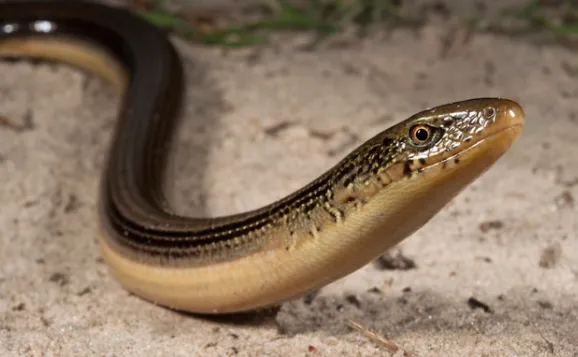
Scientific Information
- Scientific Name: Ophisaurus ventralis
- Common Names: Eastern Glass Lizard, Eastern Legless Lizard
Origins and Habitats
The Eastern Glass Lizard is native to the southeastern United States. Its range stretches from southern Virginia, down through Florida, and westward to parts of Louisiana. They are typically found in areas with loose, sandy soil, such as sandhills, pine flatwoods, coastal dunes, and grassy fields.
Physical Characteristics
- Size: Adult Eastern Glass Lizards typically measure between 18 to 43 inches in length, including their long tail. Their weight is modest, given their legless, slender body.
- Body Features: Despite being called a lizard, the Eastern Glass Lizard is legless, often leading to it being mistaken for a snake. However, a few distinct features set them apart from snakes, including movable eyelids and external ear openings. Another fascinating aspect of the Eastern Glass Lizard is its ability to shed its tail (autotomy) when threatened, which can then regrow, although not to its original length.
- Coloration and Patterns: The Eastern Glass Lizard’s dorsal coloration varies from olive to brown, occasionally with a golden tint. Some individuals possess dark longitudinal lines, while others may have a series of dark spots that merge to form a lateral stripe.
Diet
Eastern Glass Lizards are carnivores, primarily preying on insects such as beetles, grasshoppers, and spiders. They will also consume small vertebrates, including amphibians and other reptiles, if the opportunity arises.
Environmental Impact
Eastern Glass Lizards are a natural part of the ecosystems they inhabit, playing a role in controlling insect populations. However, like many reptiles, they face habitat loss due to human activities, which can lead to declines in their populations. Preservation of their habitats is crucial for their continued survival and the overall health of the ecosystems they inhabit.
24. Island Glass Lizard (Ophisaurus compressus)
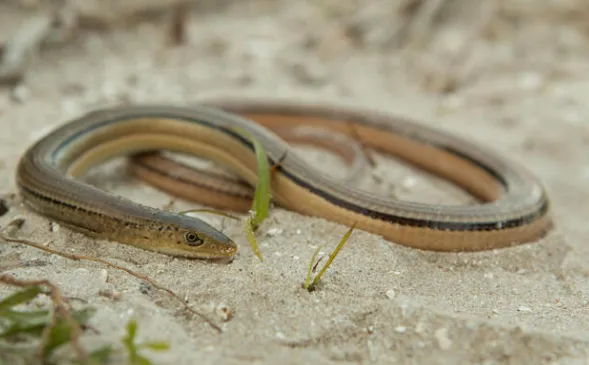
Scientific Information
- Scientific Name: Ophisaurus compressus
- Common Names: Island Glass Lizard
Origins and Habitats
The Island Glass Lizard is primarily found in the southeastern coastal areas of the United States. Its presence is mainly noted in coastal dunes, scrub habitats, and pine flatwoods of peninsular Florida. The “island” in its common name refers to its preference for sandy, isolated habitats, though it’s not exclusive to actual islands.
Physical Characteristics
- Size: Typically, the Island Glass Lizard ranges in length from 18 to 30 inches. Given its slender, legless appearance, it’s lightweight.
- Body Features: Similar to other glass lizards, the Island Glass Lizard is legless, making it easy to confuse with snakes. Distinguishing features that help identify it as a lizard include movable eyelids, external ear openings, and a groove on the sides of its body, which is absent in snakes. They also have the unique capability to drop their tail, a defense mechanism when faced with predators, which can then regrow over time.
- Coloration and Patterns: The dorsal surface is usually brown or olive with dark-edged pale lateral stripes. Additionally, they have a pale stripe down the middle of their back.
Diet
Island Glass Lizards have a carnivorous diet, feeding primarily on arthropods like beetles, spiders, and crickets. They are also known to consume small amphibians and reptiles when the opportunity arises.
Environmental Impact
The Island Glass Lizard plays an important role in its native habitat by helping regulate insect populations. However, habitat loss due to development, land alteration, and other human-related activities is a significant threat to this species. Maintaining and protecting its natural habitats is vital not only for the survival of the Island Glass Lizard but also for the overall health and balance of the ecosystems in which they reside.
25. Mimic Glass Lizard (Ophisaurus mimicus)
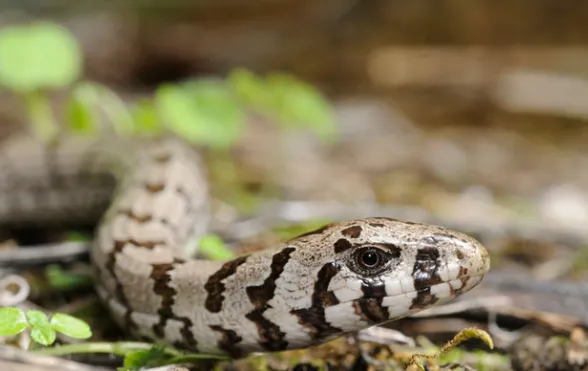
Scientific Information
- Scientific Name: Ophisaurus mimicus
- Common Names: Mimic Glass Lizard
Origins and Habitats
The Mimic Glass Lizard is native to the southeastern United States, predominantly found in parts of Florida and Georgia. This lizard prefers open pine woods, grasslands, and sandy areas. The name “mimic” likely comes from its resemblance to other glass lizards, making it a bit tricky to differentiate just by a passing glance.
Physical Characteristics
- Size: The Mimic Glass Lizard can grow to lengths ranging from 15 to 28 inches. Its slender and legless body makes it a lightweight reptile.
- Body Features: Much like other glass lizards, this species is legless and often mistaken for snakes. However, it can be distinguished as a lizard due to features such as movable eyelids, external ear openings, and a noticeable lateral groove. A fascinating feature of this lizard is its ability to drop and later regrow its tail as a defense mechanism against predators.
- Coloration and Patterns: Typically, the Mimic Glass Lizard has a light brown or olive-green dorsal surface, decorated with a pale stripe down its back. There may also be dark spots or bands, especially in younger individuals.
Diet
Mimic Glass Lizards have a carnivorous diet mainly consisting of insects like beetles and crickets. Additionally, they also feed on spiders and occasionally small amphibians.
Environmental Impact
The Mimic Glass Lizard plays a valuable role in the ecosystem by keeping insect populations in check. However, as with many other reptiles, they face threats due to habitat loss from human activities, including urban development and agriculture. Ensuring the protection and conservation of their habitats is vital not just for the Mimic Glass Lizard, but also for maintaining the ecological balance in the regions they inhabit.
26. Slender Glass Lizard (Ophisaurus attenuatus)
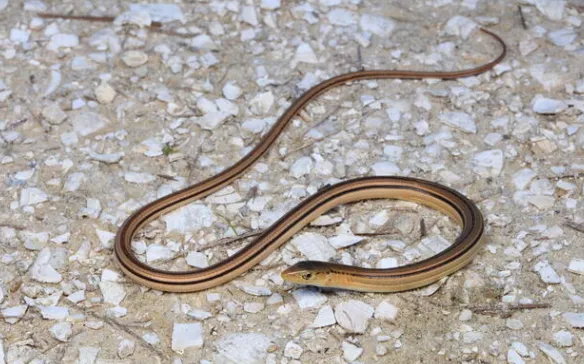
Scientific Information
- Scientific Name: Ophisaurus attenuatus
- Common Names: Slender Glass Lizard, Slender Glass Snake
Origins and Habitats
The Slender Glass Lizard is predominantly found in the southeastern regions of the United States, stretching from Florida to Virginia and as far west as Oklahoma. This species prefers sandy or loamy soils, grasslands, and open woodlands, thriving particularly in areas with plenty of ground cover to hide.
Physical Characteristics
- Size: This particular species of glass lizard usually measures between 22 to 42 inches in length, making it one of the longer members of the glass lizard family.
- Body Features: The Slender Glass Lizard, as its name suggests, possesses a notably slender and elongated body, making it frequently mistaken for a snake. However, the presence of eyelids and external ear openings quickly differentiate it from its slithering counterparts. Its tail comprises a significant portion of its total length and can break off as a defense mechanism to distract predators.
- Coloration and Patterns: Its dorsal side often carries a greenish-brown or tan hue with dark spots that can merge to form longitudinal lines. The belly, in contrast, is typically creamy or pale.
Diet
These lizards primarily feed on arthropods, which include beetles, grasshoppers, and spiders. They also occasionally consume small vertebrates, such as tiny amphibians.
Environmental Impact
The Slender Glass Lizard helps in controlling insect populations within its habitat, contributing positively to the balance of its ecosystem. Like other species in its family, it faces threats like habitat destruction due to urbanization and agriculture. Preserving their natural habitats and minimizing human interference is crucial for the survival and health of their populations.
27. Green Iguana (Iguana iguana)
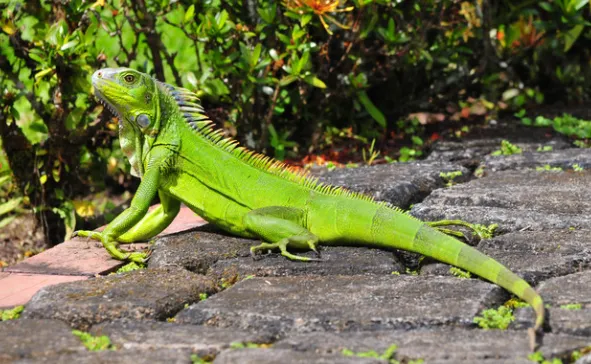
Scientific Information
- Scientific Name: Iguana iguana
- Common Names: Green Iguana, Common Iguana
Origins and Habitats
Native to Central and South America and parts of the Caribbean, the Green Iguana has become a familiar sight in other parts of the world, including Florida. In their native habitats, they thrive in a variety of environments ranging from rainforests to savannas. Their preference for habitats near water sources, such as rivers and lakes, is evident in their adept swimming abilities.
Physical Characteristics
- Size: Green Iguanas are among the largest lizards in the Americas. Adults can reach lengths of up to 6.5 feet, including their tail, and weigh anywhere from 9 to 20 pounds.
- Body Features: Characterized by their robust build, Green Iguanas have a row of spines running from their neck to the tip of their long, muscular tails.
- Coloration and Patterns: True to their name, they are primarily green, though the exact shade can vary. Juveniles tend to be a brighter green, while adults may have a more subdued or even slightly brownish hue. Accents of blue, orange, or black might also be present, especially in mature males.
Diet
Omnivorous by nature, Green Iguanas predominantly feed on leaves, fruits, and flowers in the wild. However, they will occasionally consume insects, small animals, and bird eggs. In suburban areas, they’ve been known to feast on bird eggs, causing concerns among bird conservationists.
Environmental Impact
The introduction of Green Iguanas in areas outside their native range, especially in Florida, has presented various environmental challenges. They compete with native wildlife for
28. Spinytail Iguana (Ctenosaura pectinata)
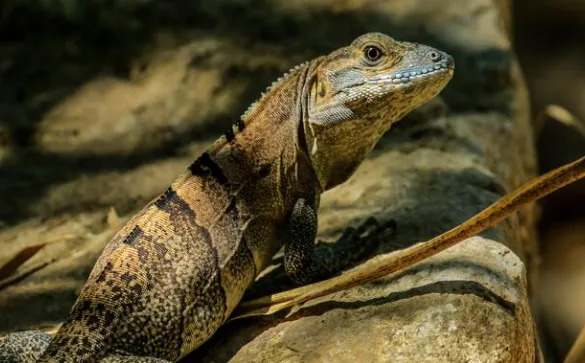
Scientific Information
- Scientific Name: Ctenosaura pectinata
- Common Names: Spinytail Iguana, Mexican Spiny-tailed Iguana, Guanajuato Spiny-tailed Iguana
Origins and Habitats
The Spinytail Iguana is native to western Mexico, from the state of Sinaloa to the Isthmus of Tehuantepec. This lizard is well-suited to the hot, arid environments of its homeland and is commonly found in rocky terrains, tropical dry forests, and scrub habitats. In these areas, the Spinytail Iguana often seeks out crevices, burrows, or rock piles to take shelter and bask in the sun.
Physical Characteristics
- Size: Adult Spinytail Iguanas can range from 12 inches to over 5 feet, depending on the exact subspecies, with the tail accounting for a significant portion of that length. These iguanas can weigh anywhere from a pound to several pounds, with males typically being larger than females.
- Body Features: Their name “Spinytail” is derived from the keeled scales and pronounced spines that run down their tails. These spines become more prominent with age.
- Coloration and Patterns: These iguanas are typically gray or tan with a mix of darker banding patterns across their bodies. As they age, males may display more vibrant colorations, with hints of orange, yellow, or even blue, especially during mating seasons.
Diet
Predominantly herbivores, Spinytail Iguanas consume a wide variety of plants, including flowers, leaves, and fruits. However, they’re also known to be opportunistic eaters and might consume insects, smaller animals, and eggs if the opportunity presents itself.
Environmental Impact
While Spinytail Iguanas play an important role in their native ecosystem, balancing vegetation and providing a
29. Brown Basilisk (Basiliscus vittatus)
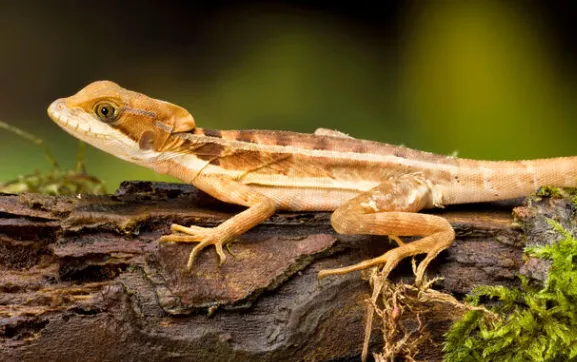
Scientific Information
- Scientific Name: Basiliscus vittatus
- Common Names: Brown Basilisk, Striped Basilisk, Jesus Christ Lizard
Origins and Habitats
The Brown Basilisk is indigenous to Central America, ranging from Belize to northwestern Colombia. Its preferred habitats include lowland forests, shrublands, and areas near freshwater streams, ponds, or rivers. The presence of water is vital for this species as they are well known for their ability to “run” short distances across water, a feat that earned them the nickname “Jesus Christ Lizard.”
Physical Characteristics
- Size: Brown Basilisks are generally medium-sized lizards, with adults reaching lengths of up to 24 inches, including their long, whip-like tail. They are lightweight, aiding their ability to skitter across water surfaces.
- Body Features: One of the Brown Basilisk’s most distinctive features is the high crest that males have on their heads, backs, and tails. This crest is less pronounced in females.
- Coloration and Patterns: As the name suggests, this lizard has a primarily brown coloration, but it may also display shades of olive and gray. A series of dark bands are often visible on the body and tail.
Diet
The diet of the Brown Basilisk primarily consists of insects, but they’ve also been known to eat small vertebrates, including smaller lizards and amphibians. They also consume plant material occasionally, making them omnivorous.
Environmental Impact
Originally from Central America, the Brown Basilisk has been introduced to some parts of Florida, where it has become an invasive species. Although they’re not as damaging as some other invasive species, they compete with native species for
30. Florida Sand Skink (Neoseps reynoldsi)
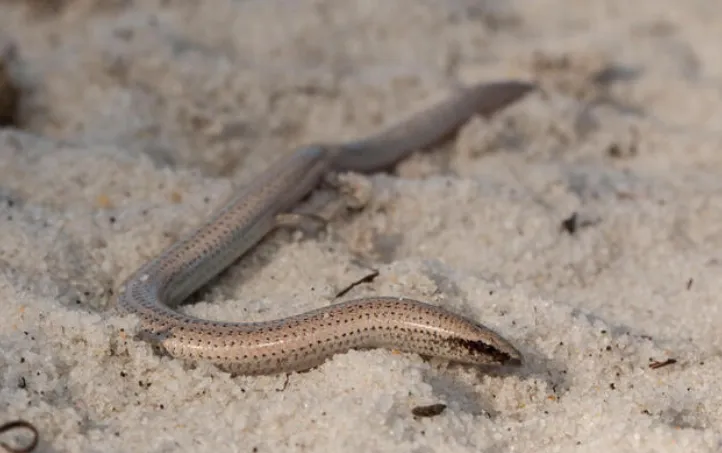
Scientific Information
- Scientific Name: Neoseps reynoldsi
- Common Names: Florida Sand Skink
Origins and Habitats
Endemic to the sandy ridges of central Florida, the Florida Sand Skink has made its home in the unique scrub habitats of the region. These areas are characterized by loose, well-drained sands which the skink utilizes to “swim” beneath the surface. These sandy soils are typically associated with ancient dunes and are found in areas that have a scrubby vegetation dominated by oak and palmetto.
Physical Characteristics
- Size: The Florida Sand Skink is a small lizard, typically reaching lengths of 4 to 5 inches including its tail.
- Body Features: This skink is limbless, with only tiny, stub-like legs. Its body is elongated, and it has a wedge-shaped head, which aids in its sand-swimming behavior.
- Coloration and Patterns: It sports a smooth, shiny, and sleek body that is generally a golden-brown or beige color. This coloration helps it blend seamlessly with its sandy surroundings.
Diet
Primarily insectivorous, the Florida Sand Skink’s diet consists of small insects and invertebrates, such as beetles and ant larvae, which they hunt beneath the sand’s surface. Their unique adaptation of “swimming” in the sand enables them to sneak up on and catch their prey.
Environmental Impact
The Florida Sand Skink is an essential indicator species for the health of Florida’s scrub habitats. Its presence or absence can give conservationists valuable insights into the health and vitality of these ecosystems. Unfortunately, with the increasing urbanization of central Florida, the skink’s habitats are under threat, leading to a decline in their numbers.
The loss of their habitat due to urban development, agriculture, and fire suppression in scrub habitats has led to the Florida Sand Skink being listed as a threatened species. Conservation measures are in place to protect their habitats and ensure the survival of this unique and fascinating creature.
31. Jamaican Giant Anole (Anolis garmani)
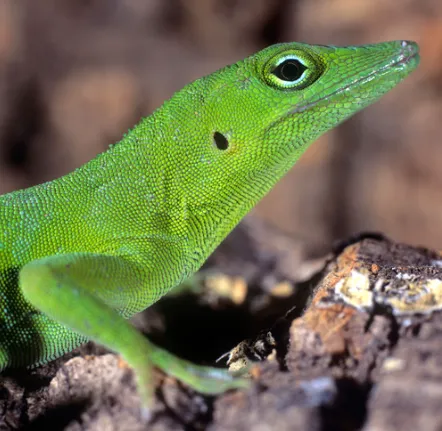
Scientific Information
- Scientific Name: Anolis garmani
- Common Names: Jamaican Giant Anole, Garman’s Anole
Origins and Habitats
The Jamaican Giant Anole is native to Jamaica and the Bahamas. This species is found in a variety of habitats in its native range, from forests to more open areas, and is known to thrive in both wet and dry regions. Its adaptability allows it to adjust to various environments, making it a versatile species in its habitat preferences.
Physical Characteristics
- Size: Adult Jamaican Giant Anoles are fairly large compared to other anole species, with males reaching lengths of up to 20 cm (8 inches) from snout to vent, and females slightly smaller.
- Body Features: This species has a robust and well-built physique. Males possess a larger dewlap, which is a flap of skin that can be extended for displays, compared to females. The dewlap coloration can vary but is often yellowish to orangish-red with blue-gray bordering.
- Coloration and Patterns: The Jamaican Giant Anole is often a bright green or brownish-green, with coloration that can change based on mood, temperature, and surroundings. Some may also display a pattern of stripes or spots, though this is less common.
Diet
Jamaican Giant Anoles are insectivorous, primarily feeding on various insects like crickets, beetles, and moths. However, they can also consume other small animals when the opportunity arises.
Environmental Impact
While the Jamaican Giant Anole plays a crucial role in its native habitat by controlling insect populations, it can become problematic when introduced to new areas. In places where it’s not native, such as Florida, it might compete with local species for
32. Reef Gecko (Sphaerodactylus notatus)
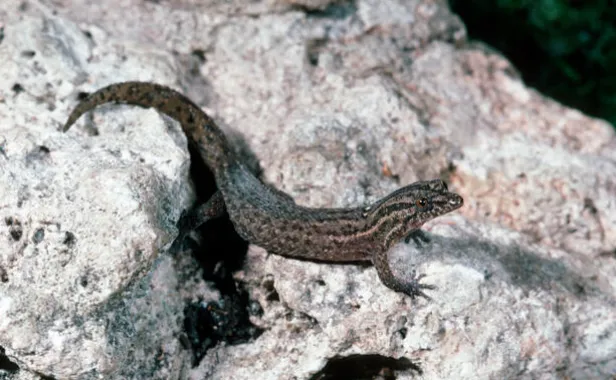
Scientific Information
- Scientific Name: Sphaerodactylus notatus
- Common Names: Reef Gecko, Florida Reef Gecko
Origins and Habitats
The Reef Gecko is native to the southeastern United States, especially Florida, and parts of the Caribbean. It thrives in a range of habitats, from hardwood forests to scrubby areas and coastal regions. Given its small size, it can easily hide under leaf litter, logs, and other ground debris.
Physical Characteristics
- Size: Among the smallest geckos in the world, the Reef Gecko measures only about 3 to 4 cm (1.2 to 1.6 inches) in total length, including its tail.
- Body Features: The Reef Gecko has a slender body, delicate structure, and a relatively large head for its size. It is equipped with clawed feet, a typical characteristic for ground-dwelling geckos.
- Coloration and Patterns: This gecko showcases a variety of colors and patterns. It often possesses a brownish or tan background color adorned with darker bands or blotches. The underbelly tends to be paler. Its small size, combined with its camouflaging colors, makes it quite inconspicuous in its natural habitat.
Diet
Being insectivores, Reef Geckos primarily feed on tiny insects such as ants, mites, and fruit flies. Occasionally, they might consume other small invertebrates.
Environmental Impact
The Reef Gecko plays an integral role in its native habitats by regulating insect populations. It serves as a
Reef Geckos are a perfect example of the diverse reptilian life found in Florida and the surrounding regions. Their small size and cryptic nature mean they often go unnoticed, but they play a crucial role in maintaining the ecological balance in their habitats.
33. Curly-tailed Lizard (Leiocephalus carinatus)
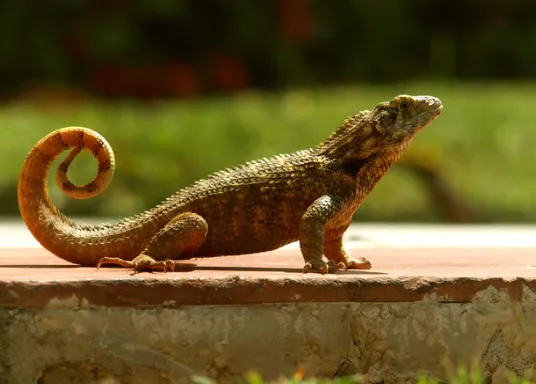
Scientific Information
- Scientific Name: Leiocephalus carinatus
- Common Names: Curly-tailed Lizard, Northern Curly-tailed Lizard
Origins and Habitats
The Curly-tailed Lizard is native to the Bahamas, the Cayman Islands, and Cuba. Over time, it has been introduced to some areas of Florida. It primarily occupies sunlit, open spaces with sandy or rocky substrates, such as beaches, scrublands, and open woodlands.
Physical Characteristics
- Size: Curly-tailed Lizards are moderately sized, generally ranging between 4 to 11 inches in length, depending on the specific species.
- Body Features: These lizards get their common name from their unique ability to curl their tails, especially when they are agitated or excited. Their bodies are robust and streamlined, with rough, keeled scales giving them a slightly rugged appearance.
- Coloration and Patterns: Typically, they possess a grayish-brown or greenish-brown dorsal coloration. This may be complemented by dark bands, spots, or longitudinal stripes depending on the specific species and individual. Their bellies are lighter, often with a pale yellow or cream shade.
Diet
The Curly-tailed Lizard’s diet is diverse. They’re omnivores and consume a mixture of insects, fruits, flowers, and even small vertebrates. Being opportunistic feeders, they’re known to eat almost anything they can overpower.
Environmental Impact
In places where they’ve been introduced, such as Florida, there are concerns about their impact on native species. Their opportunistic feeding habits mean they could out-compete native lizards for
34. Cuban Ameiva (Pholidoscelis auberi)
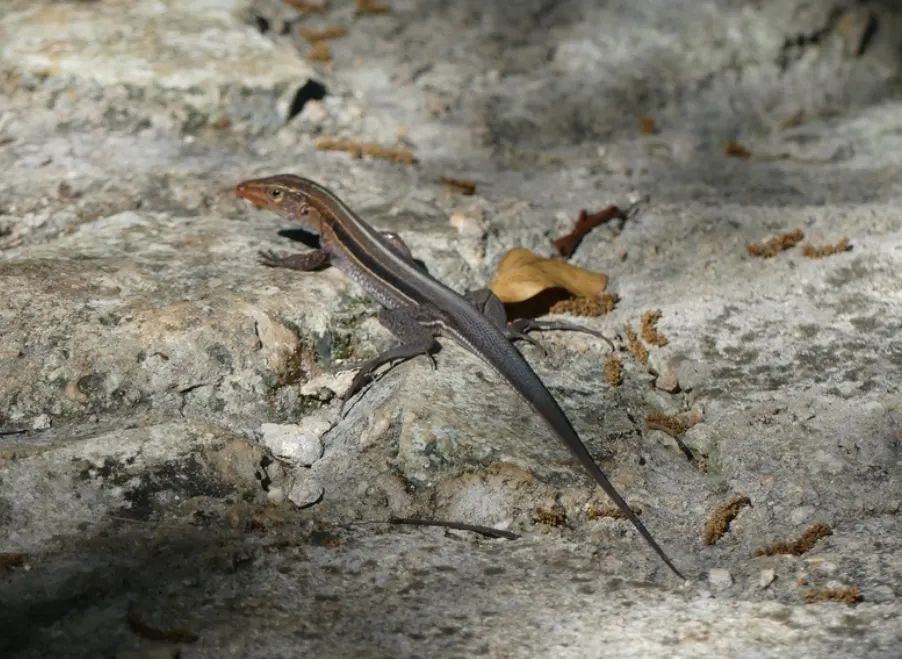
Scientific Information
- Scientific Name: Pholidoscelis auberi
- Common Names: Ameiva, Cuban Ameiva, Cuban Giant Ameiva
Origins and Habitats
The Ameiva, specifically the Pholidoscelis auberi species, is indigenous to Cuba. However, it can also be found in the Bahamas and has been introduced to some parts of Florida. These lizards prefer open habitats such as grasslands, clearings, and lightly wooded areas, though they can also be seen sunning themselves on rocks and logs.
Physical Characteristics
- Size: The Ameiva can range from 5 to 20 inches in length, depending on the specific species and gender, with males generally being larger.
- Body Features: Ameivas have a streamlined, elongated body accompanied by a long tail. Their limbs are well-developed, facilitating quick and agile movements.
- Coloration and Patterns: Their dorsal surface typically exhibits a greenish or olive hue, sometimes adorned with dark lateral stripes or spots. The underside is usually lighter, ranging from white to yellowish, often accompanied by dark speckles or streaks.
Diet
Ameivas are omnivores, meaning they have a varied diet. They predominantly feed on insects such as beetles, crickets, and spiders. However, they also consume plant matter like fruits, seeds, and flowers, especially when insects are less abundant.
Environmental Impact
In their native regions, Ameivas play a pivotal role in controlling insect populations. They also serve as a
35. Eastern Fence Lizard (Sceloporus undulatus)
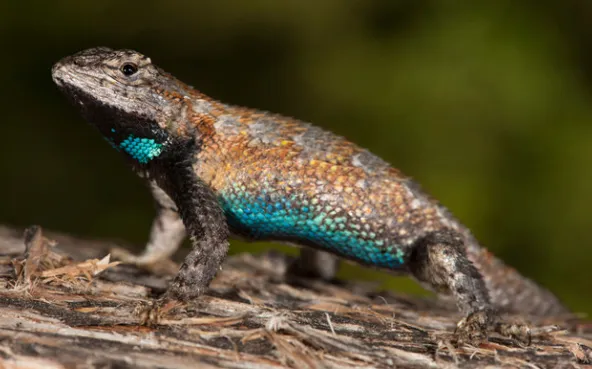
Scientific Information
- Scientific Name: Sceloporus undulatus
- Common Names: Eastern Fence Lizard, Pine Lizard, Prairie Lizard
Origins and Habitats
The Eastern Fence Lizard is native to the southeastern and central United States, spanning areas from New York to Florida and west to parts of Kansas and Oklahoma. They prefer wooded areas, particularly pine woodlands, as well as rocky outcrops, overgrown fields, and, as their name suggests, they can often be found basking on wooden fences.
Physical Characteristics
- Size: Typically, they range from 4 to 7.25 inches in length, including their tail. They are lightweight, weighing just a few grams.
- Body Features: The Eastern Fence Lizard has a robust, somewhat flattened body with a pronounced head. Their legs are well-developed and strong, assisting them in swift movements when threatened.
- Coloration and Patterns: Males exhibit a more vibrant coloration than females. Their background color is generally gray to brown with wavy crossbands across their back and tail. Males often have a bright blue patch on their throats and bellies, while females and juveniles might display a series of dark lines on their backs. Females may also possess a scattering of white spots on their back.
Diet
Eastern Fence Lizards are insectivores, primarily feeding on ants, beetles, spiders, and other small invertebrates. They are adept hunters, using their quick reflexes to catch prey.
Environmental Impact
Being a native species, the Eastern Fence Lizard plays an essential role in its ecosystem by controlling insect populations. Furthermore, they are a vital
36. Madagascar Giant Day Gecko (Phelsuma grandis)
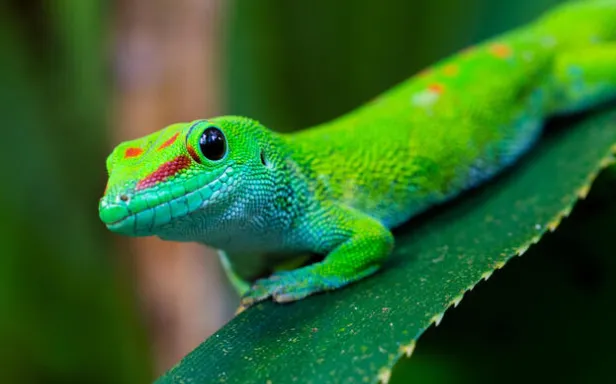
Scientific Information
- Scientific Name: Phelsuma grandis
- Common Names: Madagascar Giant Day Gecko
Origins and Habitats
The Madagascar Giant Day Gecko hails from, as its name suggests, the vast rainforests and coastal areas of Madagascar. Over time, however, it has also been introduced to several areas outside its native range. This vibrant lizard enjoys basking on tree trunks, often in direct sunlight, and thrives in humid, tropical environments.
Physical Characteristics
- Size: This is one of the largest species of day geckos, with adults typically reaching lengths of 9 to 11 inches. They have a moderately robust build, perfectly suited for their arboreal lifestyle.
- Body Features: The Madagascar Giant Day Gecko is a true arboreal beauty. It has a flattened body adapted to life among tree trunks and branches. Its toes are equipped with adhesive pads, which give it the ability to scale smooth surfaces with ease.
- Coloration and Patterns: A striking, vivid green dominates the body of the Madagascar Giant Day Gecko, making it a favorite among reptile enthusiasts. Its back often showcases a pattern of red spots, while its eyes, a brilliant and captivating red, contrast vividly against its emerald body. The vibrant color not only aids in camouflage amidst the lush green foliage but also makes them stand out in the pet trade.
Diet
An omnivorous creature, the Madagascar Giant Day Gecko primarily feeds on various insects like crickets, beetles, and other small invertebrates. However, they also have a taste for sweet nectars and fruits, showcasing their diverse palate.
Environmental Impact
In their native Madagascar, these geckos play a vital role in controlling insect populations. However, in places where they’ve been introduced, such as Florida, they can outcompete and push out native species, potentially upsetting ecological balances. Florida, with its favorable tropical climate, has seen a surge in non-native species introductions, and the presence of the Madagascar Giant Day Gecko is a testament to the adaptability of this vibrant reptile in new environments.
37. Gold Dust Day Gecko (Phelsuma laticauda)
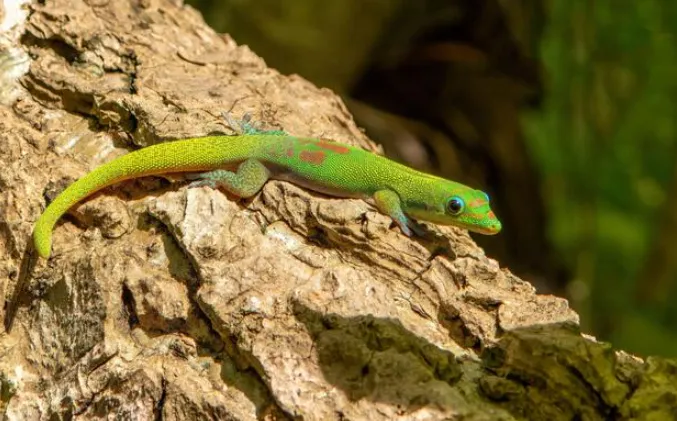
Scientific Information
- Scientific Name: Phelsuma laticauda
Origins and Habitats
The Gold Dust Day Gecko hails from Madagascar and the Comoros islands. Within these places, these vibrant geckos are commonly found in both natural and human-altered environments. They often inhabit trees, bushes, and man-made structures, preferring areas where they can readily find
Physical Characteristics
- Size: Typically, these geckos measure around 4 to 5 inches in length.
- Body Features: What makes the Gold Dust Day Gecko truly stand out are its bulging, vibrant eyes without eyelids, and its toe pads, which allow it to skillfully navigate even the most slippery surfaces.
- Coloration and Patterns: Their bright green bodies are adorned with a red stripe from the nostril to the eye and three teardrop-shaped red markings between the head and base of the tail. Their backs are sprinkled with gold specks, which is where they get their “Gold Dust” name.
Diet
Gold Dust Day Geckos are primarily insectivores, feeding on a variety of insects. Additionally, they have a sweet tooth for nectar and fruit, making them occasional frugivores.
Environmental Impact
In their native regions, these geckos help control insect populations, offering a form of natural pest control. However, when introduced to new areas, such as Hawaii, they can become invasive. Their adaptability allows them to thrive, but this can lead to competition with native species, potentially upsetting local ecosystems. Although they’re not reported to be invasive in Florida, it’s a reminder of the possible impacts non-native species can have when introduced to new environments.
38. Veiled Chameleon (Chamaeleo calyptratus)
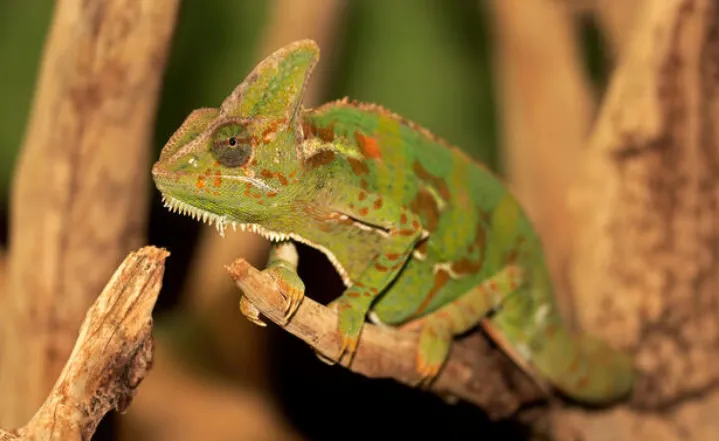
Scientific Information
- Scientific Name: Chamaeleo calyptratus
Origins and Habitats
Originating from the southwestern regions of Saudi Arabia and Yemen, the Veiled Chameleon is known to inhabit a range of altitudes and terrains, from coastal plains to mountainous regions. In its natural habitat, the Veiled Chameleon can usually be found in areas of dense vegetation, which provides it with ample camouflage and opportunities to hunt for prey.
Physical Characteristics
- Size: Males tend to be larger than females, with adult males reaching lengths of up to 24 inches including their tail, while females are usually about half that size.
- Body Features: One of the most distinct features of the Veiled Chameleon is the large casque, or helmet-like ridge, on top of their heads, which becomes more pronounced as they age. This casque helps channel water that falls on their heads to their mouths. Their zygodactyl feet, combined with a prehensile tail, allow for excellent gripping abilities in trees.
- Coloration and Patterns: While they start off a pale green as juveniles, as they mature, they develop intricate patterns of bright gold, green, blue, and yellow, with tinges of orange or black, depending on their mood, health, and temperature. Their color-changing ability is a marvel and a primary characteristic of chameleons.
Diet
Primarily insectivores, Veiled Chameleons feast on a range of insects. In captivity, they’re often fed crickets, but in the wild, their diet is more diverse, including locusts, beetles, and other small invertebrates. Larger chameleons might also snack on small vertebrates. Additionally, they consume plant matter occasionally.
Environmental Impact
The Veiled Chameleon, when introduced to non-native regions, can potentially become invasive, competing with local wildlife for resources. For example, in Hawaii, where they have been introduced, there’s concern over their potential impact on the local ecosystem, though they aren’t classified as invasive. Florida, a state with a mild climate and vast suitable habitats, also keeps an eye on such exotic pet species, as they can easily establish themselves in the wild if released or if they escape.
39. Peter’s Rock Agama (Agama picticauda)
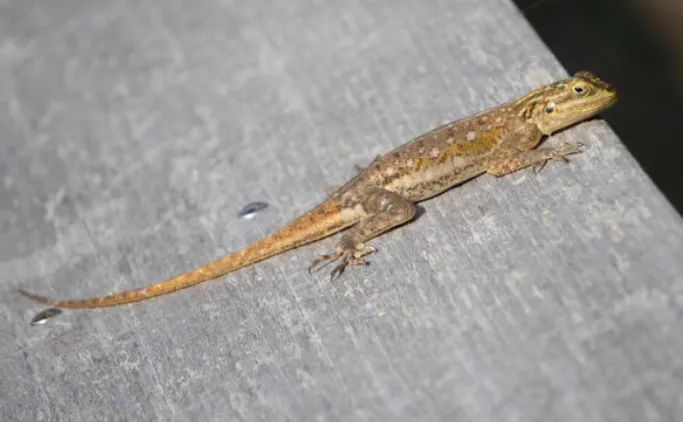
Scientific Information
- Scientific Name: Agama picticauda
Origins and Habitats
Peter’s Rock Agama is native to parts of Eastern Africa, spanning regions like Kenya and Tanzania. These lizards have an affinity for rocky terrains, which provides them with ample hiding spots and strategic vantage points. They typically gravitate towards escarpments, rocky outcrops, and similar structures in their native habitats.
Physical Characteristics
- Size: Typically, adult Peter’s Rock Agamas can reach lengths of about 6 to 9 inches. Males are generally larger than females.
- Body Features: These agamas possess a robust and slightly flattened body. They have long toes, which are an adaptation for their rocky habitats.
- Coloration and Patterns: Males, when trying to attract a mate or assert dominance, will often display bright colors. They may show off a combination of blue and orange or red, particularly on the head and neck. Females and non-dominant males are usually brown or tan with some mottling or patterns.
Diet
Peter’s Rock Agamas are primarily insectivorous, preying on a range of insects like beetles, ants, and termites. They might also consume small invertebrates. When resources are scant, they might also nibble on vegetation.
Environmental Impact
While Peter’s Rock Agama is a fascinating creature in its native region, it has established populations in areas outside its native range, such as in Florida. In non-native regions, there is potential for competition with local wildlife and a disruption of the natural ecological balance. Their increasing presence, especially in Florida, is viewed with some concern due to the potential environmental implications.
40. Rainbow Ameiva (Holcosus undulatus)
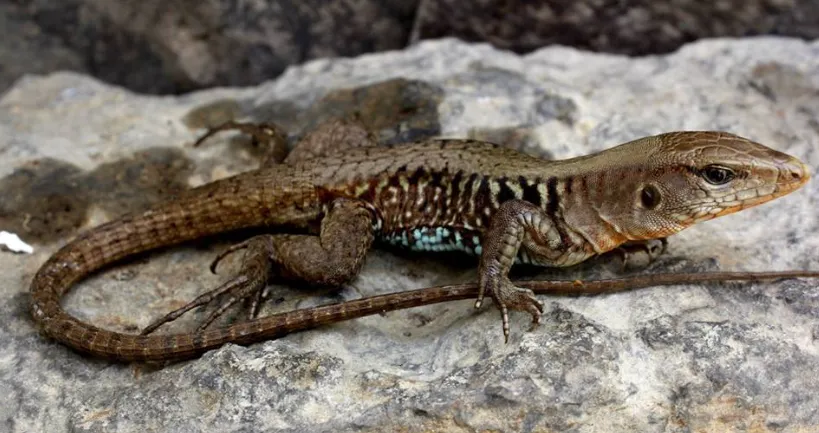
Scientific Information
- Scientific Name: Holcosus undulatus
Origins and Habitats
The Rainbow Ameiva is native to Central and South America, spanning from Costa Rica down to Colombia. These ground dwellers are typically found in open habitats such as grasslands, light forests, and savannas, where they can use their speed to dart in and out of cover.
Physical Characteristics
- Size: Adult Rainbow Ameivas can reach lengths of 10 to 14 inches, with nearly two-thirds of that length being their tail. They possess a slender, elongated body built for swift movement.
- Body Features: This lizard is characterized by its sleek form, long tail, and swift running abilities. Its legs are well-developed, indicating its ground-dwelling nature and preference for running over climbing.
- Coloration and Patterns: As their name suggests, Rainbow Ameivas boast a vibrant and variable color palette. While their dorsal side is predominantly gray to olive-green, they often display a series of orange to red lateral stripes. Their ventral side is usually lighter, sometimes exhibiting blue shades. The variety and brilliance of their colors become particularly pronounced during mating seasons or territorial displays.
Diet
Rainbow Ameivas are omnivorous. Their diet primarily consists of insects, including beetles, crickets, and spiders. They also consume fruits, seeds, and other plant matter, and won’t hesitate to prey on smaller animals if given the chance.
Environmental Impact
In their natural habitats, Rainbow Ameivas contribute to the ecosystem by controlling insect populations and serving as a
Q&A Section
Q: What is the rarest lizard to find in Florida?
A: The rarest lizard in Florida is the coal skink, recognizable by its dark stripes.
Q: What is the fastest lizard in Florida?
A: The Six-lined Racerunner is known for its speed.
Q: What is the largest native lizard in Florida?
A: The Eastern Glass Lizard is one of the largest native lizards in Florida.
Q: How long do lizards in Florida live?
A: Lifespan varies by species, but many common lizards in Florida live 5-8 years.
Q: Why are there so many lizards in Florida?
A: Florida’s warm climate and diverse habitats make it ideal for many lizard species.
Q: Are Florida lizards safe to touch?
A: Most are harmless, but it’s always good to be cautious, especially with wild animals.
Q: What do lizards in Florida eat?
A: Their diet varies, but many eat insects like cockroaches, while others might eat small mammals or even other lizards.
Q: Are the lizards in Florida poisonous?
A: No, but the monitor lizard can deliver a painful bite.
Q: Do basilisk lizards live in Florida?
A: Yes, both the Green Basilisk and the Brown Basilisk can be found in Florida.
Q: Are tegu lizards in Florida?
A: Yes, the Black and White Tegu has become an invasive species in Florida.
Q: Can you own a monitor lizard in Florida?
A: With the right permit, but they’re considered invasive, so there are restrictions.
Q: How to repel lizards in Florida?
A: Keeping your home clean and free from insects can deter lizards.
Q: Are lizards in Florida poisonous to dogs?
A: No, but some lizards might cause digestive upset if ingested.
Q: What are the tiny little lizards in Florida called?
A: One of the most common tiny lizards in Florida is the Brown Anole.
Q: What lizards bite in Florida?
A: While many lizards can bite if threatened, the monitor lizard has a particularly strong bite.
Q: What is the biggest lizard in Florida?
A: The invasive Nile Monitor is one of the biggest lizards found in Florida.
Q: Are brown anoles safe to touch?
A: Generally, yes, but they can be skittish and may try to escape.
Q: What are the invasive species of lizards in Florida?
A: Some invasive species include the Black and White Tegu, Nile Monitor, and the Brown Basilisk.
Q: What lizard looks like an iguana in Florida?
A: The Green Iguana and Spinytail Iguana are both commonly found in Florida.
Q: Are brown lizards in Florida invasive?
A: If you’re referring to the Brown Anole, yes, they are invasive but now widespread in Florida.
Q: What lizards are found in Florida?
A: Florida hosts a variety of lizards, including the Green Anole, Broadhead Skink, and Florida Worm Lizard, among others.
- Enchi Ball Python: A Unique and Stunning Morph of Python regius - March 27, 2025
- Emerald Tree Monitor: The Enigmatic Green Guardian of the Rainforest - March 26, 2025
- The Egyptian Cobra (Naja haje): A Fascinating Serpent - March 25, 2025
